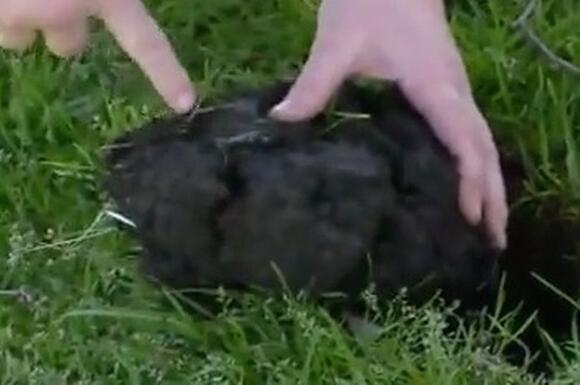A deadly fungal cicada disease is turning the insects into "zombies" as swarms of mites flood Chicago and the Midwest in a massive invasion .
The disease has been described by an entomologist as "even stranger than science fiction" — but it's incredibly real. Called Massospora, the fungal parasite is known to infect cicadas and essentially turn them into the "walking dead."
First, the spores infect the bugs, which begin producing "conidia," a type of fungal spore that makes them highly infections to other adult cicadas . Then, the cicadas start producing "wing-flick signals as if they were females — making them highly attractive to cicadas of both sexes," John Cooley, an entomologist at the University of Connecticut told NBC Chicago .

The second stage of the infection infects the cicadas with "conidiospores," which allow them to infect the next generation of cicada nymphs, Cooley told the publication. Those nymphs won't emerge for another 13 or 17 years, he said, but the damage will have been done.
At that point, any cicadas become "flying saltshakers of death," Matt Kasson of National Geographic wrote in an article about the deadly fungus. Then there's the really disgusting part — in male cicadas , the fungus will literally rip their gonads from their bodies and force chalky spores to be spread to other cicadas nearby, Cooley said.
The infection effectively sterilizes the insects — but it doesn't kill them. It helps the fungus spread to other insects. "They're completely at the mercy of the fungus," Cooley told NBC Chicago. "They're walking dead."
Click here to follow the Mirror US on Google News to stay up to date with all the latest news, sports and entertainment stories.

Eventually, the fungus destroys the entire lower half of infected insects, Peter Gwin of National Geographic said, turning them into "overcaffeinated flying machine" that are designed to spread spores in the ground, which then infect young, burrowing cicadas .
The fungus may also produce psychoactive chemicals, though what purpose they have isn't yet clear, NBC Chicago reported. But when birds munch on the infected bugs, they experience hallucinatory effects, according to Cooley.
Signs of the fungus are distinct in infected bugs, leaving them looking "chalky white," Kasson wrote, "either like a middle school eraser or like a math teacher's chalk." He said it becomes "definitely noticeable that something's wrong with the backside of the cicada."
Residents of Chicago have reported seeing bugs infected by the fungus, which Cooley generally referred to as a "sexually transmitted zombie disease." Primarily, the fungus has been spotted in the Midwest, but it has the potential to spread to other areas.
Around 10% of the insects seem to be infected in some regions of the Midwest, Cooley said, but the exact numbers aren't clear. The fungus has also been detected in Missouri, officials said, according to NBC Chicago.
The important thing to note amid the historic cicada emergence, however, which saw trillions of the bugs emerge across the Midwest and other areas of the U.S., is that the fungus doesn't pose a threat to humans, according to the Virginia Museum of Natural History.
According to the facility, "While this is all pretty horrifying, Massospora cicadina may play an important role in controlling cicada populations and preventing cicadas from causing too much damage to tree roots while they're in the nymph stage." The museum continued, "Nature always finds a way, even if it is fairly disgusting."
What are the dangers of cicadas?
While the great cicada invasion might now be over, there's one lingering impact from it — mites. There's a particular type of mite called the "oak leaf itch mite," according to Dr. Gene Kritsky of Mount St. Joseph University, which has been seen in massive numbers following the historic emergence.
The mites reportedly were found in 2007 during the last large cicada emergence in Chicago in the egg nests of Brood XIII cicadas. That brood emerged this year, Kritsky told NBC Chicago .
Of the mites, Krisky said, "This is actually sort of the last hurrah, if you will, of the cicada emergence — to cause this itchy irritation." He said those bitten by the mites experience itchy rashes.
The rashes are often red in color on the skin and can also include papules, researchers from Penn State told NBC Chicago, which are small, white, raised bumps. The mites first appeared, the university said, in the fall of 2004 in Kansas, with about 19,000 cases of the rash reported, and has since spread to Illinois, Nebraska, Ohio, Oklahoma, Missouri and other states.
"Although they have been reported to feed upon many different insects, it is when they have become very numerous, eliminating their current food source, that they will search for alternative hosts and inadvertently bite humans," Penn State said.
The actual mites themselves are reddish-tan in color and have shiny exoskeletons and four pairs of legs. "Studies have shown that the mites can fall from trees in numbers of up to 370,000 per day," Penn State wrote. "They are also easily carried by the wind and can potentially enter through window screens and thereby bite people who do not often go outdoors. Most bites, however, occur to individuals gardening, especially those raking infested pin oak leaves in the fall."
Mites can take up to four hours to bite their host if they land on a human, it was reported, and can then lead to mild, itchy rashes or bigger bumps. The best thing to do is not to itch the spots where the bites have occurred and to use anti-itch cream, where helpful. If it gets worse, see a doctor, the Illinois Department of Public Health recommends. Bite rashes can last up to two weeks.
To prevent mite bites, the IDPH recommends avoiding sitting under infested trees and the lawns around them and to wash clothes and shower with warm, soapy water after potential exposures, including after working outside, especially near oak trees.


 Local News
Local News

